java基础
环境搭建
Python,解释型编程语言。
# xx.py
print("爬虫逆向开发")
print("结束")>>>Python解释器的路径 代码文件的路径
>>>C:\python39\python.exe 代码文件的路径
C:\python39\加入环境变量。
>>>python xx.pyJava,编译型&解释型语言。(编译型 vs 解释器)
// Hello.java
String name = "武沛齐";
System.out.println(name);在执行代码时,需要对代码先进行编译。
>>>java安装bin目录下javac Hello.java
>>>javac Hello.java
Hello.class编译完成之后,你会得到一个文件 Hello.class,去运行代码。
>>>java HelloJRE,( Java Runtime Envrionment ),Java 运行时环境。
含JVM和运行必备的类库。
电脑上想要运行java程序,就必须安装JRE。
JDK,( Java Development Kit ),Java开发工具。【包含JRE】【Java开发】
含JRE 和 开发必备的工具。
工具包含:编译工具javac.exe 和 运行工具java.exe
想要开发Java应用程序,就必须安装JDK。
接下来,我们就来下载和安装吧。
JDK8(jdk 1.8)版本(目前最新已到17)
官方地址:https://www.oracle.com/java/technologies/downloads/#java8
安装好之后需要配置下环境变量。
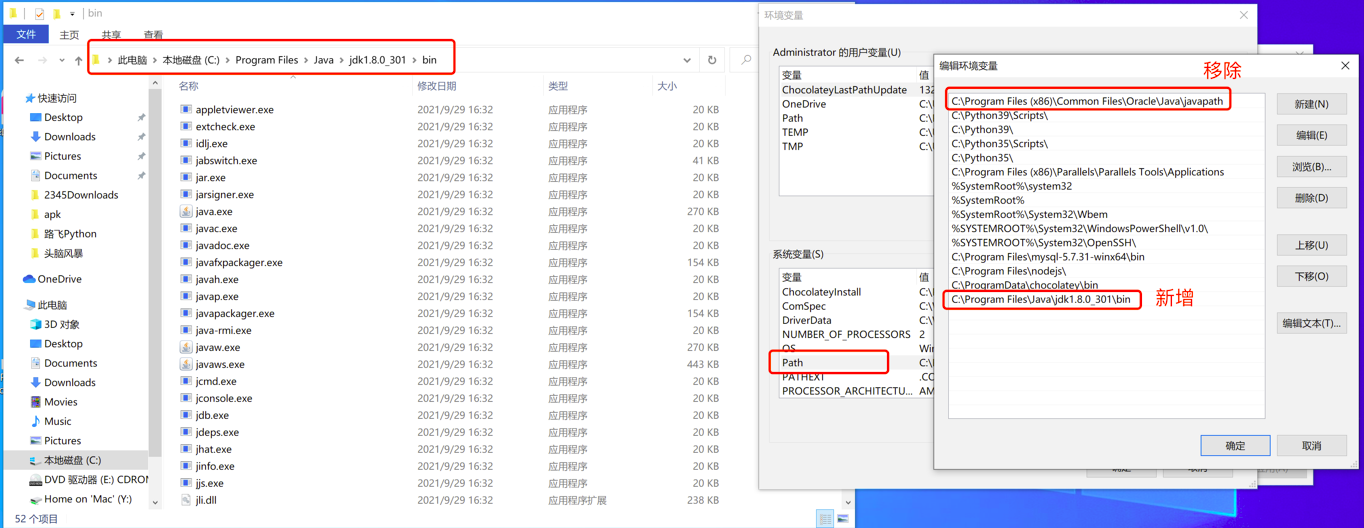

关于mac系统,自带JDK:

/Library/Java/JavaVirtualMachines 
编写代码+编译+运行:
编写Java代码:Hello.java
public class Hello {
public static void main(String[] args) {
System.out.println("Hello World");
}
}打开终端去运行命令
>>>javac Hello.java
>>>java HelloInteliji
编写Java代码时建议大家使用IDE(集成开发环境)来提供开发效率。
下载,建议【2020.1.1版本】: https://www.jetbrains.com/idea/download/other.html
激活:视频:https://www.zhihu.com/zvideo/1254435808801050624
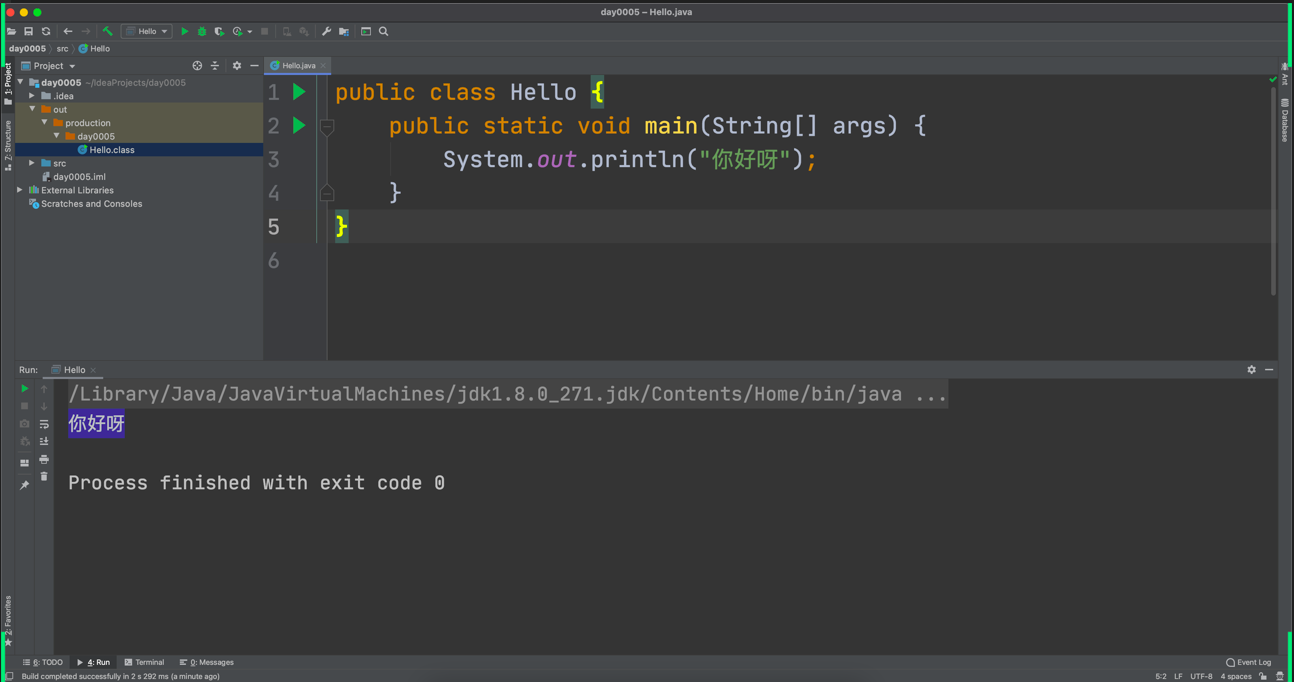
java基本语法
初步代码的分析:Hello.java
public class Hello {
public static void main(String[] args) {
System.out.println("你好呀");
}
}public,其他的类可以访问这个函数。
static,静态函数(不需要实例化也能使用)。
void,函数无返回值。
main:主函数 & 程序的入口。
String[] args:参数必须要指定类型(强制)。
文件名
一个文件中最多只能有一个public类 且 文件名必须和public类名一致。
如果文件中有多个类,文件名与public类名一致。
如果文件中有多个类 且 无public类,文件名可以是任意类名。类名
首字母大写且驼峰式命名,例如:Hello、UserInfo、PersonApplication类修饰符:public、default(不写)
类中成员修饰符:public、private、protected、default(不写)
静态成员,无序实例化就可以指定调用。
class MyTest{
public void f1(){
System.out.println("f1");
}
public static void f2(){
System.out.println("f2");
}
}
public class Hello {
public static void main(String[] args) {
MyTest.f2();
//1.实例化
MyTest obj = new MyTest();
// 2.对象调用
obj.f1();
}
}
class Person{
public static void f1(){
// 静态方法
System.out.println("我是F1函数");
}
}
public class Hello {
public static void main(String[] args) {
Person.f1();
}
}class Person {
public void f2() {
// 实例方法
System.out.println("我是F1函数");
}
}
public class Hello {
public static void main(String[] args) {
// 实例化对象 obj = Person();
Person obj = new Person();
// 对象调用f2
obj.f2();
}
}void表示方法没有返回值
class MyTest{
public int f1(){
System.out.println("f1");
return 123;
}
public static String f2(){
System.out.println("f2");
return "哈哈哈";
}
}
public class Hello {
public static void main(String[] args) {
MyTest obj = new MyTest();
int v1 = obj.f1();
String v2 = MyTest.f2();
}
}
参数
class MyTest {
public int f1(int a1, int a2) {
int result = a1 + a2;
return result;
}
}
public class Hello {
public static void main(String[] args) {
MyTest obj = new MyTest();
int v1 = obj.f1(1, 2);
}
}补充:
# Python 官方源代码不也有java这样写的么?
def func(a1,a2):
return a1 + a2
# 建议
def foo(a1: str a2:int) -> int
return 1
foo(11,22)注释
/**
* 对这个类进行注释
*/
public class Hello {
/**
* 这个方法是干嘛....
* @param v1 大小
* @param v2 尺寸
* @return 返回一个xxx
*/
public static String getSign(int v1, String v2) {
return "哈哈哈";
}
public static void main(String[] args) {
// 单行注释 #
// int age = 18;
/* 多行注释 """sdfafd"""
String name = "武沛齐";
int size = 18;
*/
}
}变量和常量
public class Hello {
public static void main(String[] args) {
String name = "武沛齐";
name = "alex";
int age = 19;
age = 20;
// 用 final 定义常量后不能修改
final int size = 18;
}
}import java.util.Scanner;
public class Hello {
public static void main(String[] args) {
// 输入
Scanner input = new Scanner(System.in);
String text = input.nextLine();
// 输出 line
System.out.println(text);
// System.out.print(text);
}
}import java.util.Scanner;
public class Hello {
public static void main(String[] args) {
// 输出
System.out.print("请输入:");
// 输入
Scanner input = new Scanner(System.in);
String text = input.nextLine();
// 输出
System.out.println(text);
}
}条件语句
public class Hello {
public static void main(String[] args) {
int age = 19;
if (age < 18) {
System.out.println("少年");
} else if (age < 40) {
System.out.println("大叔");
} else {
System.out.println("老汉");
}
if (age < 18) {
System.out.println("少年");
}
if (age < 18) {
System.out.println("少年");
} else {
System.out.println("老汉");
}
}
}public class Hello {
public static void main(String[] args) {
int score = 19;
switch (score) {
case 10:
System.out.println("xxx");
System.out.println("xxx");
System.out.println("xxx");
break;
case 20:
System.out.println("xxx");
System.out.println("xxx");
System.out.println("xxx");
break;
default:
System.out.println("xxx");
break;
}
}
}循环语句
while循环
public class Hello {
public static void main(String[] args) {
int count = 10;
while (count < 3) {
System.out.println("执行中...");
count += 1;
}
}
}do while循环(至少执行1次)
public class Hello {
public static void main(String[] args) {
int count = 0;
do {
System.out.println("执行中...");
count += 1;
} while (count < 3);
}
}for循环
public class Hello {
public static void main(String[] args) {
for (int i = 0; i < 10; i++) {
System.out.println("哈哈哈");
}
}
}public class Hello {
public static void main(String[] args) {
String[] nameList = {"修仙", "肖峰", "麻子", "十分"}; //=>列表
// nameList.length 4 len(xx)
// nameList[0]
for (int idx = 0; idx < nameList.length; idx++) {
String ele = nameList[idx];
System.out.println(ele);
}
}
}注意:也支持break/continue。
数据类型
字节类型
byte,字节 【1字节】表示范围:-128 ~ 127 即:-2^7 ~ 2^7 -1
public class Demo {
public static void main(String[] args) {
byte v1 = 99;
byte v2 = 1;
byte v3 = (byte) (v1 + v2);
System.out.println(v3);
System.out.println(Integer.toBinaryString(v1));
System.out.println(Integer.toHexString(v1));
int n1 = Integer.parseInt("b",16);
System.out.println(n1);
}
}
# 在python中,字符串转换成字节,或者十进制
v1 = "武沛齐"
v2 = v1.encode('utf-8')
print(v2)
# 结果为: b'\xe6\xad\xa6\xe6\xb2\x9b\xe9\xbd\x90'
# 如果对 v2 进行循环输出十进制的内容
print([i for i in v2])
# 输出结果为: [230, 173, 166, 230, 178, 155, 233, 189, 144]
# 一一对应的关系为:
# 武: \xe6\xad\xa6 230, 173, 166
# 沛: \xe6\xb2\x9b 230, 178, 155
# 齐: \xe9\xbd\x90 233, 189, 144
print(v1.encode('gbk'))
# 结果为: b'\xce\xe4\xc5\xe6\xc6\xeb'
# 武: \xce\xe4
# 沛: \xc5\xe6
# 齐: \xc6\xeb单纯的字节类型,一般就是用来表示数字。
有时候字符串会通过字节来表示,是为了方便底层存储或者网络传输。
一般用的比较多的是对字节数组的数据。例如:
提醒:逆向时有一些字符串是通过字节数组来表示(UTF-8编码)
v1 = "武沛齐"
v2 = [230, 173, 166, 230, 178, 155, 233, 189, 144]import java.util.Arrays;
public class Hello {
public static void main(String[] args) {
// 1.字节数组(转换为字符串) [字节,字节,字节]
byte[] dataList = {97, 105, 100, 61, 50, 52, 54, 51, 56, 55, 53, 55, 49, 38, 97, 117, 116, 111, 95, 112, 108, 97, 121, 61, 48, 38, 99, 105, 100, 61, 50, 56, 57, 48, 48, 56, 52, 52, 49, 38, 100, 105, 100, 61, 75, 82, 69, 104, 69, 83, 77, 85, 74, 104, 56, 116, 70, 67, 69, 86, 97, 82, 86, 112, 69, 50, 116, 97, 80, 81, 107, 55, 87, 67, 104, 67, 74, 103, 38, 101, 112, 105, 100, 61, 48, 38, 102, 116, 105, 109, 101, 61, 49, 54, 50, 55, 49, 48, 48, 57, 51, 55, 38, 108, 118, 61, 48, 38, 109, 105, 100, 61, 48, 38, 112, 97, 114, 116, 61, 49, 38, 115, 105, 100, 61, 48, 38, 115, 116, 105, 109, 101, 61, 49, 54, 50, 55, 49, 48, 52, 51, 55, 50, 38, 115, 117, 98, 95, 116, 121, 112, 101, 61, 48, 38, 116, 121, 112, 101, 61, 51};
String dataString = new String(dataList);
System.out.println("字符串是:" + dataString);
// 2.字符串->字节数组
try {
// Python中的 name.encode("gbk")
String name = "武沛齐";
byte[] v1 = name.getBytes("GBK");
System.out.println(Arrays.toString(v1)); // [-50, -28, -59, -26, -58, -21]
// Python中的 name.encode("utf-8")
byte[] v2 = name.getBytes("UTF-8");
System.out.println(Arrays.toString(v2)); // [-26, -83, -90, -26, -78, -101, -23, -67, -112]
} catch (Exception e) {
}
}
}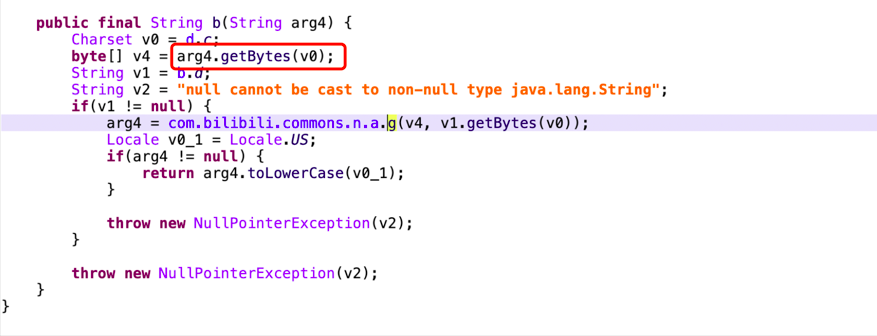
看完python和java中的输出,分别不一样:
python中:[230, 173, 166, 230, 178, 155, 233, 189, 144]
java中: [-26, -83, -90, -26, -78, -101, -23, -67, -112]原因是:Python是无符号的(不含负数的),而Java是有符号的(含有负数的)。在Java中的字节范围:-128~127;Python中字节的范围:0~255。
java, 有符号:-128~127
python,无符号:0~255观察下面java和python的一一对比可以发现规律:java和python的正数是一样的,差别在于java中负数和python的不一样,而java中负数加上256等于python中的对应的值。
Java 0 1 2 3 4 .. 127 -128 -127 -126 -3 -2 -1
Python 0 1 2 3 4 .. 127 128 129 130 ...253 254 255
需求来了:某个app逆向,在Java代码中得到一个字节数组 [-50,-28,-59,-26,-58,-21](注意这个是gbk编码),请通过Python代码将这个字节数组转换成字符串?
byte_list = [-50,-28,-59,-26,-58,-21]让数字转化弄成字节并拼接起来 bytearray
# Python脚本,方便你们以后使用。
byte_list = [-50, -28, -59, -26, -58, -21]
bs = bytearray() # python字节数组
for item in byte_list:
if item < 0:
item = item + 256
bs.append(item)
str_data = bs.decode('gbk') # data = bytes(bs)
print(str_data)data_list = [-26, -83, -90, -26, -78, -101, -23, -67, -112]
num_list = bytearray()
for i in data_list:
if i < 0:
i = i + 256
num_list.append(i)
text = num_list.decode('utf-8')
print(text)整数类型
- byte,字节 【1字节】表示范围:-128 ~ 127 即:
-2^7 ~ 2^7 -1 - short,短整型 【2字节】表示范围:-32768 ~ 32767
- int,整型 【4字节】表示范围:-2147483648 ~ 2147483647
- long,长整型 【8字节】表示范围:-9223372036854775808 ~ 9223372036854775807
public class Hello {
public static void main(String[] args) {
byte v1 = 32;
short v2 = 10000;
int v3 = 22221331;
long v4 = 554534353424L;
}
}字符
'x' -> 字符
"xxxx" -> 字符串
注意:字符串是由多个字符串组成。
char v1 = 'x';
char v2 = '武';
String = "武沛齐";字符串
定义字符串
import java.io.UnsupportedEncodingException;
public class Hello {
public static void main(String[] args) throws UnsupportedEncodingException {
String v1 = "武沛齐";
String v2 = new String("武沛齐");
String v4 = new String(new byte[]{-26, -83, -90, -26, -78, -101, -23, -67, -112});
String v5 = new String(new byte[]{-50, -28, -59, -26, -58, -21}, "GBK");
String v6 = new String( new char[]{'武', '沛', '齐'} ) ;
}
}字符串中的方法:(不用背、不用记)
public class Hello {
public static void main(String[] args) {
String origin = "alex是个大DB";
char v1 = origin.charAt(5); // 指定字符
int len = origin.length(); // 长度
for (int i = 0; i < len; i++) {
char item = origin.charAt(i);
}
String v2 = origin.trim(); // 去除空白
String v3 = origin.toLowerCase(); // 小写
String v4 = origin.toUpperCase(); // 大写
String[] v5 = origin.split("是"); // 分割 {""}
String v6 = origin.replace("D", "S"); // 替换
String v7 = origin.substring(2, 6); // 子字符串=切片 [2:6]
boolean v8 = origin.equals("alex是个大SB"); // "alex是个大DB" "alex是个大SB"
boolean v9 = origin.contains("el");
boolean v10 = origin.startsWith("a");
String v11 = origin.concat("哈哈哈");
}
}name = 'alex'
if name == 'sb':
pass字符串拼接(每个案例都用)
import java.io.UnsupportedEncodingException;
public class Hello {
public static void main(String[] args) {
//"name=alex&age=18"
// URL参数 + 请求体Form
StringBuilder sb = new StringBuilder(); // StringBuffer线程安全
sb.append("name");
sb.append("=");
sb.append("alex");
sb.append("&");
sb.append("age");
sb.append("=");
sb.append("18");
String dataString = sb.toString();
System.out.println(dataString);
}
}# Python代码改写如下:
data = []
data.append("name")
data.append("=")
data.append("18")
data_string = "".join(data)
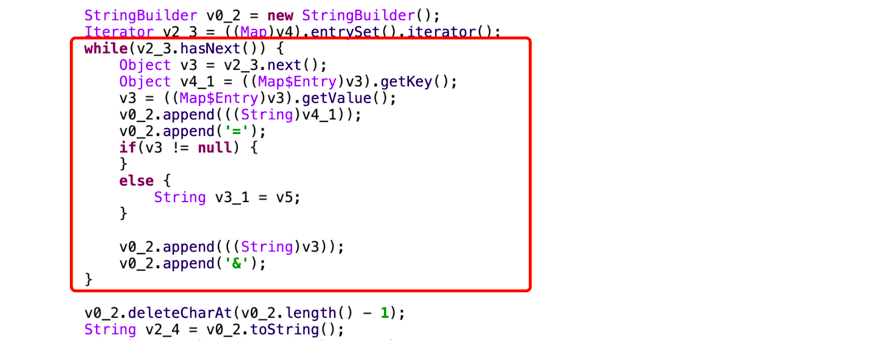

数组
存放固定长度的元素。
-
容器
-
固定长度
-
特定类型
注意:数组一旦创建个数就不可调整。
数组这种固定长度的约束太死版,所以业务上使用的不多,但是底层都是他。
import java.util.Arrays;
public class Hello {
public static void main(String[] args) {
// [123,1,99]
int[] numArray = new int[3];
numArray[0] = 123;
numArray[1] = "xxx";
numArray[2] = 99;
System.out.println(Arrays.toString(numArray));
String[] names = new String[]{"武沛齐", "alex", "eric"};
System.out.println(Arrays.toString(names));
String[] nameArray = {"武沛齐", "alex", "eric"};
System.out.println(Arrays.toString(nameArray));
// nameArray[0]
// nameArray.length
for (int idx = 0; idx < nameArray.length; idx++) {
String item = nameArray[idx];
}
}
}关于Object
在Python中每个类都默认继承Object类(所有的类都是Object的子类)。
在Java所有的类都是默认继承Object类。
int v1 = 123;
String name = "武沛齐";用基类可以泛指他的子类的类型。
import sun.lwawt.macosx.CSystemTray;
import java.util.Arrays;
public class Hello {
public static void main(String[] args) {
// String v1 = "wupeiqi";
Object v1 = new String("wupeiqi");
System.out.println(v1);
System.out.println(v1.getClass());
Object v2 = 123;
System.out.println(v2);
System.out.println(v2.getClass());
}
}
import sun.lwawt.macosx.CSystemTray;
import java.util.Arrays;
public class Hello {
public static void main(String[] args) {
// 声明数组,数组中元素必须int类型;
int[] v1 = new int[3];
// 声明数组,数组中元素必须String类型;
String[] v2 = new String[3];
// 声明数组,数组中可以是int/String类型;
Object[] v3 = new Object[3];
v3[0] = 123;
v3[1] = "wupeiqi";
}
}所以,如果以后想要声明的数组中想要是混合类型,就可以用Object来实现。
import java.util.Arrays;
public class Hello {
public static void main(String[] args) {
// v1是指字符串对象;String
String v1 = new String("wupeiqi");
String res = v1.toUpperCase();
System.out.println(res);
// v2本质是字符串对象;Object
Object v2 = new String("wupeiqi");
String data = (String)v2;
}
}
import java.util.Arrays;
public class Hello {
public static void func(Object v1) {
// System.out.println(v1);
// System.out.println(v1.getClass());
if (v1 instanceof Integer) {
System.out.println("整型");
} else if (v1 instanceof String) {
System.out.println("字符串类型");
} else {
System.out.println("未知类型");
}
}
public static void main(String[] args) {
func(123);
func("123");
}
}-
Java中所有的类都继承Object,Object代指所有的类型。
-
自己创建关系
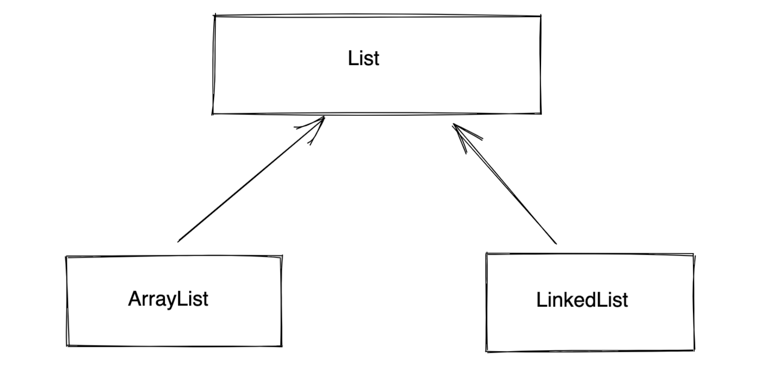
ArrayList v1 = new ArrayList();
LinkedList v2 = new LinkedList();List v1 = new ArrayList();
List v2 = new LinkedList();Object v1 = new ArrayList();
Object v2 = new LinkedList();其他”容器“
List系列
类似于Python中的列表。
List是一个接口,接口下面有两个常见的类型(目的是可以存放动态的多个数据)
-
ArrayList,连续的内存地址的存储(内部自动扩容)。 -> Python列表的特点
-
LinkedList,底层基于链表实现(自行车链条)。 -> Python列表的特点
ArrayList v1 = new ArrayList();
v1.add("武沛齐");
v1.add("麻子");LinkedList v1 = new LinkedList();
v1.add("武沛齐");
v1.add("麻子");Java中接口,是用来约束实现他的类,约束他里面的成员必须有xx。
interface List{
public void add(Object data); // 接口中的方法,不写具体的实现,只用于约束。
}
// 类ArrayList实现了接口List,此时这个类就必须有一个add方法。
class ArrayList implements List{
public void add(Object data){
// 将数据data按照连续存储的方法放在内存。
// ..
}
}
// 类LinkedList实现了接口List,此时这个类就必须有一个add方法。
class LinkedList implements List{
public void add(Object data){
// 将数据data按照链表的形式存储
// ..
}
}List v1 = new ArrayList();
v1.add("武沛齐");
v1.add("麻子");List v1 = new LinkedList();
v1.add("武沛齐");
v1.add("麻子");ArrayList示例:
import java.util.ArrayList;
import java.util.Arrays;
public class Hello {
public static void main(String[] args) {
// ArrayList,默认内部存放的是混合数据类型。
// ArrayList<String> data = new ArrayList<String>();
// ArrayList<Object> data = new ArrayList<Object>();
ArrayList data = new ArrayList();
data.add("武沛齐");
data.add("alex");
data.add(666);
data.add("tony");
String value = data.get(1);
// String value = (String) data.get(1);
Object temp = data.get(1);
String value = (String) temp; // 转化可转换的数据
System.out.println(value);
int xo = (int) data.get(2);
System.out.println(xo);
data.set(0, "哈哈哈哈");
System.out.println(data);
data.remove("eric");
data.remove(0);
System.out.println(data);
int size = data.size();
System.out.println(size);
boolean exists = data.contains("武沛齐");
System.out.println(exists);
for (Object item : data) {
System.out.println(item);
}
for (int i = 0; i < data.size(); i++) {
Object item = data.get(i);
System.out.println(item);
}
}
}LinkedList示例:
import java.util.LinkedList;
public class Hello {
public static void main(String[] args) {
// [11,22,33,4]
LinkedList<Integer> v1 = new LinkedList<Integer>();
v1.add(11);
v1.add(22);
LinkedList v2 = new LinkedList();
v2.add("有阪深雪");
v2.add("大桥未久");
v2.add(666);
v2.add(123);
//v2.remove(1);
//v2.remove("路飞");
v2.set(2, "苍老师");
v2.push("哈哈哈");
// v2.addFirst(11);
for (int i = 0; i < v2.size(); i++) {
Object item = v2.get(i);
System.out.println(item);
}
for (Object item : v2) {
System.out.println(item);
}
}
}关于迭代器:
import java.util.*;
public class Hello {
public static void main(String[] args) {
ArrayList s1 = new ArrayList();
s1.add("P站");
s1.add("B站");
s1.add("A站");
Iterator it = s1.iterator(); // 迭代器
while (it.hasNext()) {
String item = (String) it.next();
System.out.println(item);
}
}
}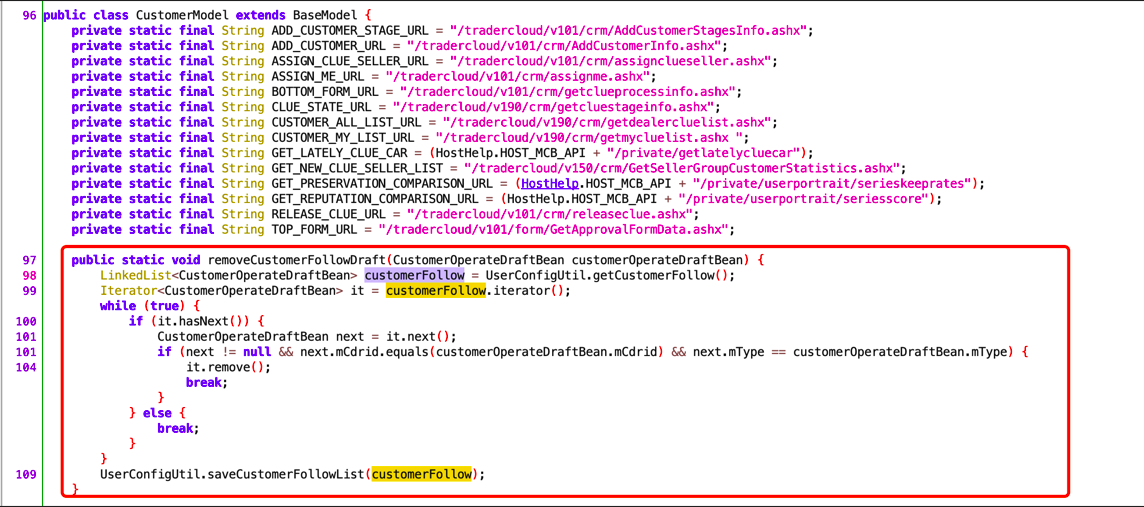
Set系列
Set是一个接口,常见实现这个接口的有两个类,用于实现不重复的多元素集合。
-
HashSet,去重,无序。
-
TreeSet,去重,内部默认排序(ascii、unicode)【不同的数据类型,无法进行比较】。
import java.util.*;
public class Hello {
public static void main(String[] args) {
// HashSet s1 = new HashSet();
// Set s1 = new HashSet();
// HashSet<String> s1 = new HashSet<String>();
HashSet s1 = new HashSet();
s1.add("P站");
s1.add("B站");
s1.add("A站");
s1.add("P站");
s1.add(666);
System.out.println(s1); // [B站, A站, P站,666]
// s2 = {"东京热","东北热","南京热"}
HashSet s2 = new HashSet(){
{
add("东京热");
add("东北热");
add("南京热");
}
};
System.out.println(s2);
// Set s2 = new TreeSet();
// TreeSet<String> s2 = new TreeSet<String>();
TreeSet s3 = new TreeSet();
s3.add("P站");
s3.add("B站");
s3.add("A站");
s3.add("P站");
// s3.add(666); //不可以
System.out.println(s3); // [B站, A站, P站]
TreeSet s4 = new TreeSet(){
{
add("P站");
add("B站");
add("A站");
add("P站");
}
};
System.out.println(s4); // [B站, A站, P站]
}
}关于交并差:
import java.util.*;
public class Hello {
public static void main(String[] args) {
// Set s1 = new HashSet();
HashSet s1 = new HashSet();
s1.add("P站");
s1.add("B站");
s1.add("A站");
s1.remove("P站");
System.out.println(s1); // [B站, A站, P站]
boolean exists = s1.contains("B站");
System.out.println(exists);
HashSet s2 = new HashSet();
s2.add(123);
s2.add(456);
HashSet v1 = new HashSet(); // 空 -> [B站, A站, P站]
v1.addAll(s1);
v1.retainAll(s2); // 交集 &
System.out.println(v1);
HashSet v2 = new HashSet();
v2.addAll(s1);
v2.addAll(s2); // 并集 |
System.out.println(v2);
HashSet v3 = new HashSet();
v3.addAll(s1);
v3.removeAll(s2); // 差集 s1 - s2
System.out.println(v3);
HashSet v4 = new HashSet();
v4.addAll(s2);
v4.removeAll(s1); // 差集 s2 - s1
System.out.println(v4);
}
}关于循环获取:
import java.util.*;
public class Hello {
public static void main(String[] args) {
TreeSet s1 = new TreeSet();
s1.add("P站");
s1.add("B站");
s1.add("A站");
for (Object item : s1) {
System.out.println(item);
}
}
}关于迭代器:
import java.util.*;
public class Hello {
public static void main(String[] args) {
TreeSet s1 = new TreeSet();
s1.add("P站");
s1.add("B站");
s1.add("A站");
Iterator it = s1.iterator();
while (it.hasNext()) {
String item = (String) it.next();
System.out.println(item);
}
}
}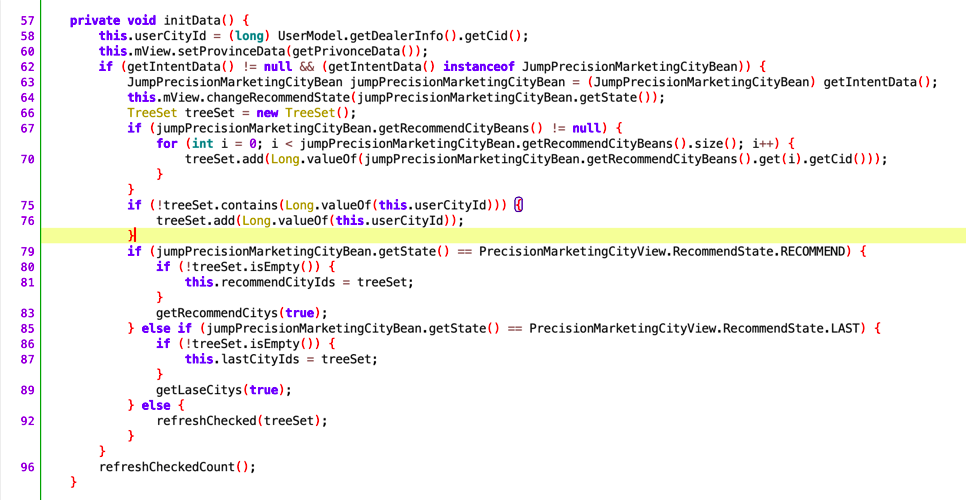
Map系列
-
HashMap,无序。
-
TreeMap,默认根据key排序。(常用)
#在Python中需要自己处理key排序的问题。 v4 = { "aid":123, "xx":999, "wid":888 } # 1.根据key进行排序 # data = ["{}={}".format(key,v4[key]) for key in sorted(v4.keys())] # 2.再进行拼接 # result = "&".join(data) result = "&".join(["{}={}".format(key,v4[key]) for key in sorted(v4.keys())])
import java.util.*;
public class Hello {
public static void main(String[] args) {
HashMap h1 = new HashMap();
h1.put("name","alex");
h1.put("age",18);
h1.put("hobby","男");
System.out.println(h1); // {gender=男, name=alex, age=18}
HashMap<String,String> h2 = new HashMap<String,String>();
h2.put("name","alex");
h2.put("age","18");
h2.put("hobby","男");
System.out.println(h2); // {gender=男, name=alex, age=18}
}
}import java.util.*;
public class Hello {
public static void main(String[] args) {
TreeMap h1 = new TreeMap(); // 改为了TreeMap
h1.put("name","alex");
h1.put("age",18);
h1.put("hobby","男");
System.out.println(h1); // {age=18, hobby=男, name=alex}
TreeMap<String,String> h2 = new TreeMap<String,String>();
h2.put("name","alex");
h2.put("age","18");
h2.put("hobby","男");
System.out.println(h2); // {age=18, hobby=男, name=alex}
Map h4 = new TreeMap();
h4.put("name","alex");
h4.put("age",18);
h4.put("hobby","男");
System.out.println(h4); // {age=18, hobby=男, name=alex}
}
}常见操作:
import java.util.*;
public class Hello {
public static void main(String[] args) {
TreeMap h1 = new TreeMap(); // 改为了TreeMap
h1.put("name", "alex");
h1.put("age", "18");
h1.put("hobby", "男");
h1.put("hobby", "女人");
h1.remove("age");
int size = h1.size();
Object value = h1.get("name"); // 不存在,返回null
System.out.println(value);
boolean existsKey = h1.containsKey("age");
boolean existsValue = h1.containsValue("alex");
h1.replace("name", "李杰");
System.out.println(h1);
// 循环: 示例1
// { ("name", "alex"),("age", "18"), }
Set<Map.Entry<String, String>> s1 = h1.entrySet();
Iterator it1 = s1.iterator();
while (it1.hasNext()) {
// ("name", "alex")
Map.Entry<String, String> entry = (Map.Entry<String, String>) it1.next();
String k = (String) entry.getKey();
String v = (String) entry.getValue();
}
// 循环: 示例2
Set s2 = h1.entrySet();
Iterator it2 = s2.iterator();
while (it2.hasNext()) {
Map.Entry entry = (Map.Entry) it2.next();
String k = (String) entry.getKey();
String v = (String) entry.getValue();
}
// 循环: 示例3
TreeMap<String, String> h2 = new TreeMap<String, String>(); // 改为了TreeMap
h2.put("name", "alex");
h2.put("age", "18");
for (Map.Entry<String, String> entry : h2.entrySet()) {
String k = entry.getKey();
String v = entry.getValue();
}
// 循环: 示例4
TreeMap h3 = new TreeMap(); // 改为了TreeMap
h3.put("name", "alex");
h3.put("age", 18);
for (Object entry : h3.entrySet()) {
Map.Entry<String, Object> entryMap = (Map.Entry<String, Object>) entry;
String k = entryMap.getKey();
Object v = entryMap.getValue(); // 18 "alex"
if (v instanceof Integer) {
System.out.println("数字:" + Integer.toString((Integer) v));
} else if (v instanceof String) {
System.out.println("字符串:" + (String) v);
} else {
System.out.println("未知类型:" + v.toString());
}
}
}
}
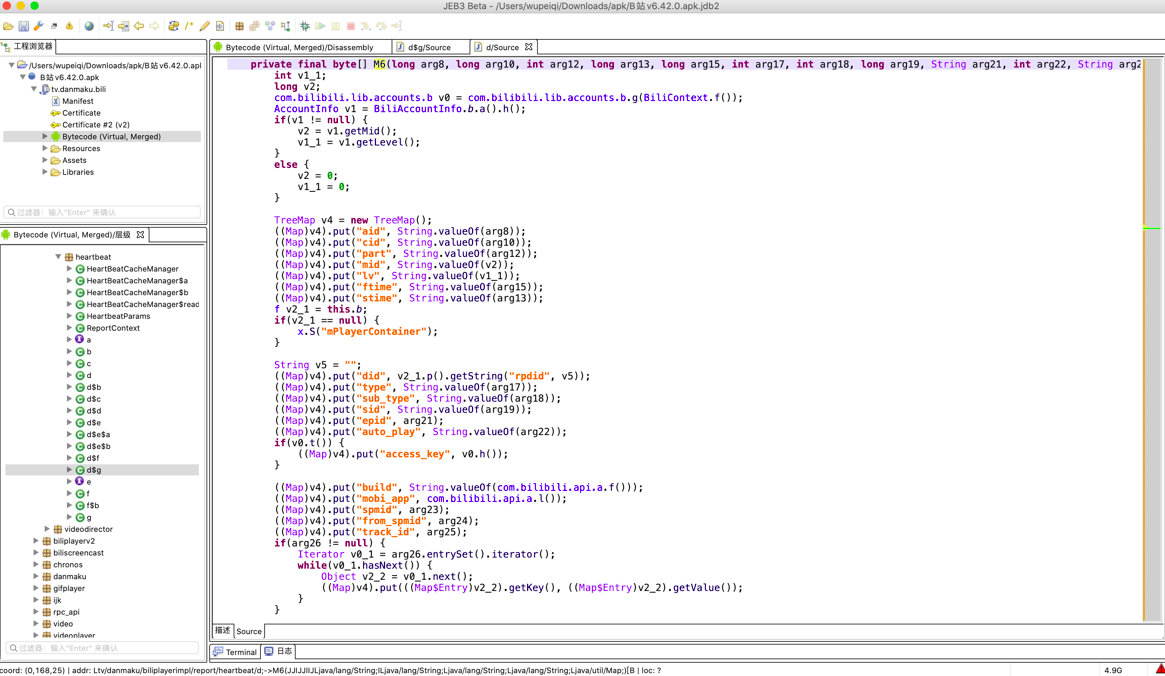
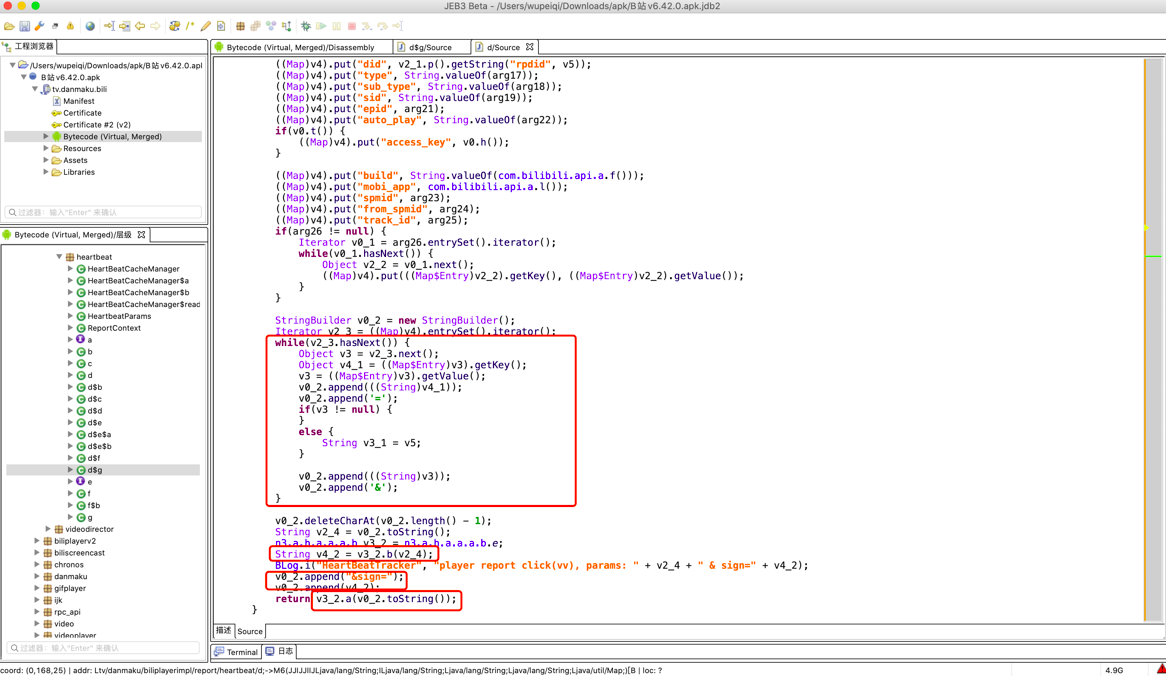
# java TreeMap 转python字典
data_dict = {
"cid": "999",
"part": "bili",
"aid": 1123,
"mid": "9999999"
}
v1 = "&".join([f"{key}={data_dict[key]}" for key in sorted(data_dict)])
print(v1)面向对象相关
-
Python,函数式+面向对象。
-
Java,面向对象。
类和对象
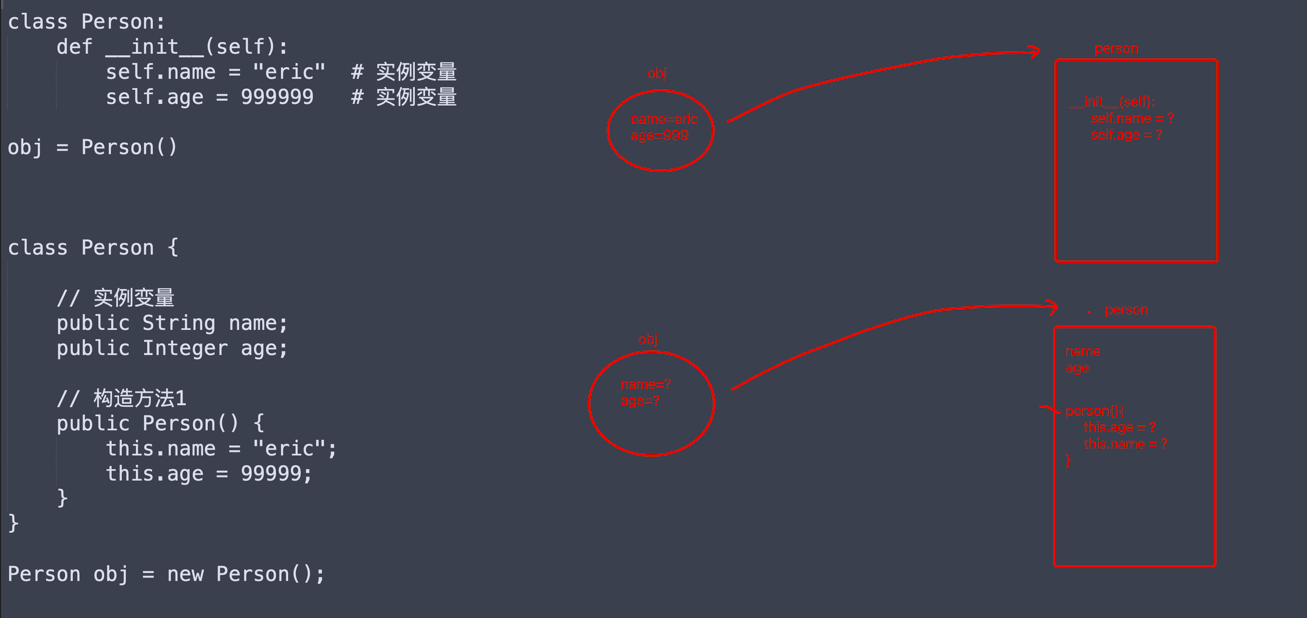
class Person {
// 实例变量
public String name;
public Integer age;
// 构造方法1
public Person() {
this.name = "Eric";
this.age = 99999;
}
}
Person obj = new Person();class Person:
# 初始化方法, 1. __new__方法,构造方法创建空对象 2.__init___方法
def __init__(self):
self.name = "eric"
self.age = 999999
obj = Person()class Person {
// 实例变量
public String name;
public Integer age;
public String email;
// 构造方法1
public Person() {
this.name = "Eric";
this.age = 99999;
}
// 构造方法2
public Person(String name, Integer age) {
this.name = name;
this.age = age;
this.email = "xxx@live.com";
}
// 构造方法3
public Person(String name, String email) {
this.name = name;
this.age = 83;
this.email = email;
}
}
Person obj1 = new Person("wupeiqi",11);
Person obj2 = new Person();
方法的重载(方法可以同名)
class Person {
// 实例变量
public String name;
public Integer age;
public String email;
// 构造方法1
public Person() {
this.name = "Eric";
this.age = 99999;
}
// 构造方法2
public Person(String name, Integer age) {
this.name = name;
this.age = age;
this.email = "xxx@live.com";
}
// 构造方法3
public Person(String name, String email) {
this.name = name;
this.age = 83;
this.email = email;
}
// 定义方法(重载)
public void doSomething() {
System.out.println(this.name);
}
// 定义方法(重载)
public void doSomething(String prev) {
String text = String.format("%s-%s", prev, this.name);
System.out.println(text);
}
}
public class Hello {
public static void main(String[] args) {
// 实例化对象时,体现的主要是封装。
Person p1 = new Person();
Person p2 = new Person("alex", 73);
Person p3 = new Person("tony", "alex@sb.com");
p1.doSomething();
p1.doSomething("你好呀,");
p2.doSomething();
p2.doSomething("你好呀,");
p3.doSomething();
p3.doSomething("你好呀,");
}
}
// 使用frida对某些类中的方法进行Hook。
// 无重载
var SafeUtils = Java.use("com.uulife.medical.utils.SafeUtils");
SafeUtils.getSign.implementation = function(j){
var res = this.getSign(j);
return res;
}
// 有重载
var SafeUtils = Java.use("com.uulife.medical.utils.SafeUtils");
SafeUtils.getSign.overload(参数).implementation = function(j,x){
var res = this.getSign(j,x);
return res;
}
// 默认运行没有重载的方式,如果没有报错,说明就是没有重载。
// 如果报错了,看提示就可以知道参数的类型,拷贝代码进去就可以了。// 使用frida对某些类中的构造方法进行Hook。
// 注意:构造方法也可能重载。
var StringBuilder = Java.use("java.lang.StringBuilder");
StringBuilder.$init.overload.implementation = function(i){
var res = this.StringBuilder(data);
return res;
}静态成员
class Foo:
v1 = "武沛齐" # 静态变量(属于类,与对象无关)
def __init__(self):
self.name = "alex" # 实例变量,属于对象
print(Foo.v1)
# 1.创建空的区域
# 2.自动执行构造方法 __init__
obj = Foo()
print(obj.name)
print(obj.v1)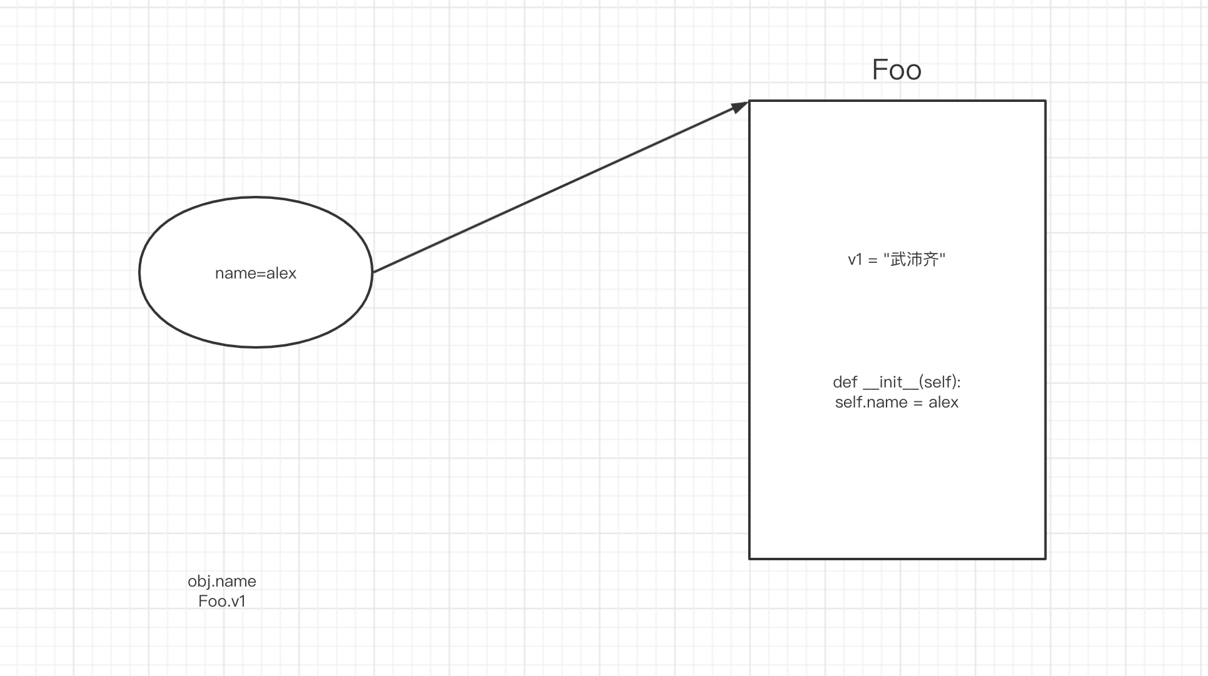
class Person {
// 静态变量
public static String city = "北京";
// 实例变量
public String name;
public Integer age;
// 构造方法1
public Person() {
this.name = "Eric";
this.age = 99999;
}
// 绑定方法
public void showInfo(){
System.out.println("哈哈哈哈");
}
// 静态方法
public static void showData(){
System.out.println("哈哈哈哈");
}
}
Person.city;
Person.showData();
Person obj = new Person();
obj.name;
obj.age;
obj.showInfo();本质:静态属于类;非静态属于对象。
继承
Java中的继承,只支持单继承,不支持多继承,但支持实现多个接口。
class Base{
...
}
class Foo{
...
}
class Son(Base){
}interface Base{
public void add();
}
interface Foo{
public void plus();
}
class Son implements Base,Foo {
public void add(){
}
public void plus(){
}
}Python中之和多继承。
class Foo(Base,Bar):
pass
class Foo(IBase,IBar):
pass
class Base {
public String email;
public Base(String email) {
this.email = email;
}
public String getSubInfo() {
return String.format("%s", this.email);
}
}
// Base obj1 = new Base("xx");
// obj1.email; // "xx"
// obj1.getSubInfo();
class Person extends Base {
public String name;
public Integer age;
public Person(String name, Integer age, String email) {
super(email);// 执行父类的构造方法
this.name = name;
this.age = age;
}
public String getInfo(String v1) {
return String.format("%s-%d-%s", this.name, this.age, this.email);
}
}
// obj2 ==> email="xxx@live.com" name="wupeiqi" age=19
Person obj2 = new Person("wupeiqi",19,"xxx@live.com");
// obj2.name;
// obj2.age;
// obj2.email;
// obj2.getInfo("xxx");
// obj2.getSubInfo();用父类泛指所有的子类。
class Base {
}
class Person extends Base {
}
Person v1 = new Person(); // v1是Person类型的对象
Base v2 = new Person(); // v2是Person类型的对象class Base {
public void show() {
System.out.println("111");
}
}
class Person extends Base {
public void show() {
System.out.println("222");
}
}
Person v1 = new Person();
v1.show(); // 222
Base v2 = new Base();
v2.show(); // 111
Base v3 = new Person();
v3.show(); // 222
class Base {
public String email;
public Base(String email) {
this.email = email;
}
public void getSubInfo() {
System.out.println("111");
}
}
// Person类继承Base类
class Person extends Base {
public String name;
public Person(String name, Integer age, String email) {
super(email);// 执行父类的构造方法
this.name = name;
}
public void getSubInfo() {
System.out.println("222");
}
}
public class Hello {
public static void handler(Base v1){
v1.getSubInfo();
}
// 主函数
public static void main(String[] args) {
Person obj1 = new Person("wupeiqi",19,"xxx@live.com");
handler(obj1); // 222
Base obj2 = new Base("xxx@live.com");
handler(obj2); // 111
Base obj3 = new Person("wupeiqi",19,"xxx@live.com");
handler(obj3); // 222
}
}接口
接口:
-
约束,实现他的类。
-
泛指
实现他了类。
interface IMessage {
public void send();
}
// Wechat类"实现"了Imessage接口
class Wechat implements IMessage {
public void send() {
System.out.println("发送微信");
}
}
class DingDing implements IMessage {
public void send() {
System.out.println("发送钉钉");
}
}
class Sms implements IMessage {
public void send() {
System.out.println("发送短信");
}
}
Wechat v1 = new Wechat();
IMessage v2 = new Wechat();public class Hello {
// 多态 -> 多种形态 IMessage
public static void handler(IMessage v1){
v1.send();
}
// 主函数
public static void main(String[] args) {
Sms v1 = new Sms();
handler(v1);
}
}在Java中:不支持同时继承多个类;支持实现多个接口。
interface IPerson {
public void f1();
public void f1(int age);
public void f2(String info);
}
interface IUser {
public String f3(int num);
}
class Base {
public String name;
public Integer age;
public String email;
public Base(String name, Integer age, String email) {
this.name = name;
this.age = age;
this.email = email;
}
public String getSubInfo() {
return String.format("%s", this.email);
}
}
class Person extends Base implements IUser, IPerson {
public Person(String name, Integer age, String email) {
super(name, age, email);
}
public String getInfo() {
return String.format("%s-%d-%s", this.name, this.age, this.email);
}
public void f1() {
System.out.println("F1,无参数");
}
public void f1(int age) {
System.out.println("F1,age参数");
}
public void f2(String info) {
System.out.println("F2");
}
public String f3(int num) {
return "哈哈哈";
}
}
public class Hello {
public static void main(String[] args) {
Person p = new Person("日天", 83, "ritian@live.com");
p.f1();
}
}假设我现在在进行逆向,拿到apk,关于关键字去搜索:f2 ,定位到一个接口了。
interface IPerson {
public void f1();
public void f1(int age);
public void f2(String info);
}接下来,你就应该去看都有哪些类 实现了 IPerson 接口。
-
只有1个类实现 IPerson。
-
多类类实现 IPerson 接口,筛选到底是那个类?
抽象
// 抽象类
abstract class Base {
// 抽象方法(约束子类中必须有这个方法)
public abstract void play(String name);
// 普通方法
public void stop() {
System.out.println("Stop");
}
}
class Son extends Base{
public void play(String name){
// ...
}
}
Son obj = new Son();
obj.stop();
obj.play();
Base obj1 = new Son();注意:也可以泛指他的子类。
包
src
├── Hello.java
└── utils
└── Helper.java
└── Db.java// hello.java
import utils.Helper;
public class Hello {
public static void main(String[] args) {
String data = Helper.getInfo();
System.out.println(data);
}
}// helper.java
package utils;
class Helper {
public static String getInfo() {
Db.?
return "哈哈哈";
}
}// helper.java
package utils;
class Db {
void f1(){
}
public static String getInfo() {
Helper.?
return "哈哈哈";
}
}类的修饰符:
-
public,公共(任何人都能调用包中的类)。
-
default,只能在当前包中被调用。
类成员修饰符:
-
public,公共,所有的只要有权限访问类,类中的成员都可以访问到。
-
private,私有,只允许自己类调用。
-
protected,同一个包 或 子类可以访问(即使没有在同一个包内,也可以访问父类中的受保护成员)。
-
default,只能在同一个包内访问。
目的:通过关键字让调用关系更加清晰(不过,很多项目不会用的那么专业)。
属性
class Person {
private String name;
public Person() {
this.name = "eric";
}
public void setName(String data){
this.name = data;
}
public String getName(){
return this.name;
}
}
Person obj = new Person();
obj.getName()
obj.setName("武沛齐")
-----------------------------------
class Person {
private String name;
public void setName(String data){
this.name = data;
}
public String getName(){
return this.name;
}
}
Person obj = new Person();
obj.getName();常见加密
隐藏字节
String salt = "sign";String v4 = new String(new byte[]{-26, -83, -90, -26, -78, -101, -23, -67, -112});示例1:
String v1 = new String(new byte[]{26, 83, 90, 26, 78, 101, 23, 67, 112});# 字节列表
byte_list = [26, 83, 90, 26, 78, 101, 23, 67, 112]
# 字节列表 -> python的字节数组
bs = bytearray()
for item in byte_list:
bs.append(item)
# python的字节数组 -> 编码 -> 字符串
str_data = bs.decode('utf-8')
print(str_data)示例2:
String v4 = new String(new byte[]{-26, -83, -90, -26, -78, -101, -23, -67, -112});
# java字节:有符号 -128 ~ 127
# python:无符号 0 ~ 255byte_list = [-26, -83, -90, -26, -78, -101, -23, -67, -112]
bs = bytearray() # python字节数组
for item in byte_list:
if item < 0:
item = item + 256
bs.append(item)
str_data = bs.decode('utf-8') # data = bytes(bs)
print(str_data)
注意事项:什么编码?(utf-8)
String v4 = new String(new byte[]{-26, -83, -90, -26, -78, -101, -23, -67, -112});# 类似于Java中的字节数组
data = "张三懵逼了"
data_bytes = data.encode('utf-8')
data_list = bytearray()
for item in data_bytes:
data_list.append(item)
res = data_list.decode('utf-8')
print(res)提醒:MD5加密盐、AES加密key、iv;
uuid
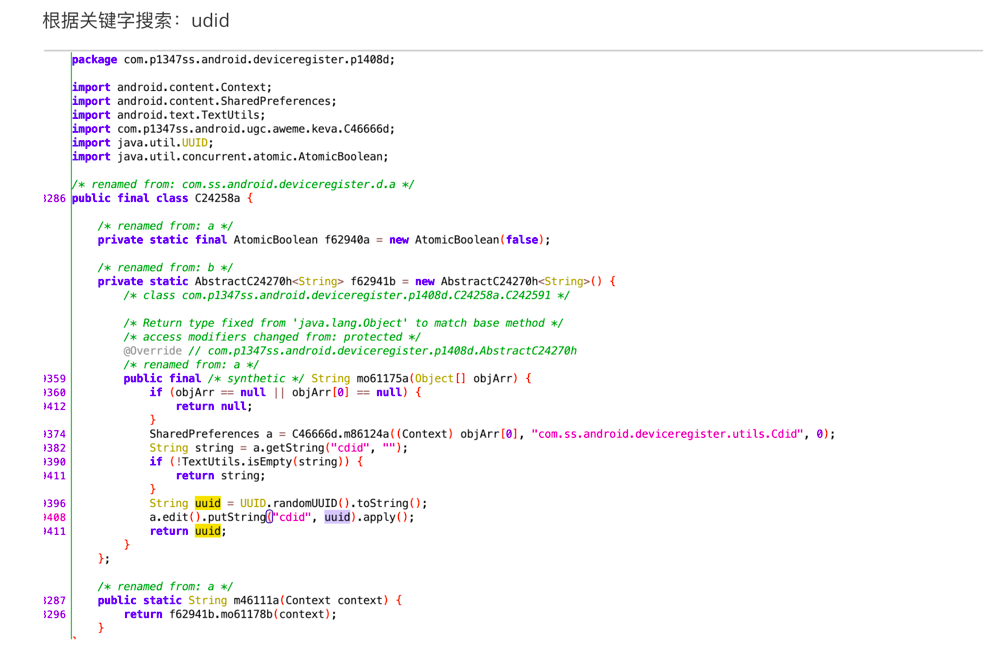
import java.util.UUID;
public class Hello {
public static void main(String[] args){
String uid = UUID.randomUUID().toString();
System.out.println(uid);
}
}import uuid
uid = str(uuid.uuid4())
print(uid)随机值

import java.math.BigInteger;
import java.security.SecureRandom;
public class Hello {
public static void main(String[] args) {
// 随机生成80位,10个字节
BigInteger v4 = new BigInteger(80, new SecureRandom());
// 让字节以16进制展示
String res = v4.toString(16);
System.out.println(res);
}
}import random
data = random.randbytes(10) # python3.9
ele_list = []
for item in data:
ele = hex(item)[2:]
res = "".join(ele_list)
print(res)data = "".join([ hex(item)[2:] for item in random.randbytes(10)])import random
data = random.randbytes(10) # pytho3.9 [199,112,88,10,232]
print( [item for item in data] )
print( [hex(item)[2:] for item in data] )
print( [hex(item)[2:].rjust(2, "0") for item in data] )
print( "".join([hex(item)[2:].rjust(2, "0") for item in data]) )import random
byte_list = [random.randint(0, 255) for i in range(10)]
print([item for item in byte_list])
print([hex(item)[2:] for item in byte_list])
print([hex(item)[2:].rjust(2, "0") for item in byte_list])
print("".join([hex(item)[2:].rjust(2, "0") for item in byte_list]))小补充:十六进制
import random
data = random.randbytes(10) # pytho3.9
ele_list = []
for item in data:
ele = hex(item)[2:].rjust(2,"0")
res = "".join(ele_list)
print(res)data = "".join([ hex(item)[2:].rjust(2,"0") for item in random.randbytes(10)])
注意:md5加密
-
Python中的md5加密: digest hexdigest
-
Java中的的md5加密:字节数组 -> 手动转换
时间戳
_ticket

public class Hello {
public static void main(String[] args) {
String t1 = String.valueOf(System.currentTimeMillis() / 1000);
String t2 = String.valueOf(System.currentTimeMillis());
System.out.println(t1);
System.out.println(t2);
}
}import time
v1 = int(time.time())
v2 = int(time.time()*1000)v1 = str(int(time.time()))
v2 = str(int(time.time()*1000))requests.post(
url="?"
json={
"xx":123
},
headers={
"ticket":121231 # 报错,一定是字符串类型
}
)十六进制的字符串
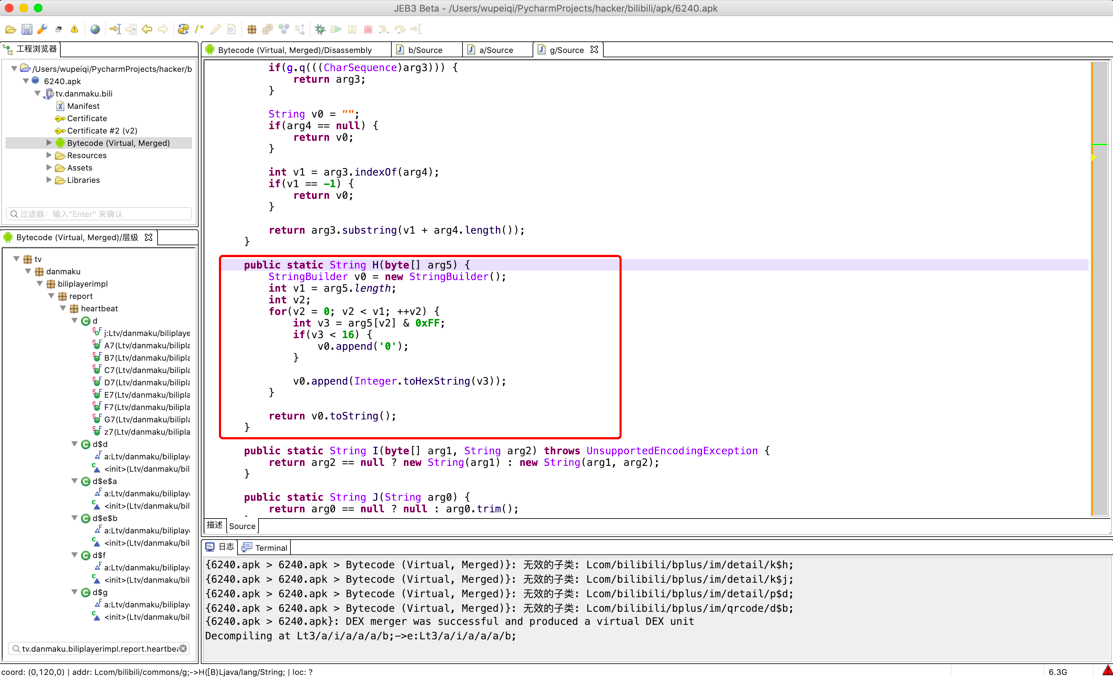
在Java中字节是有符号:-128 ~ 127
# name_bytes = "武沛齐".encode('utf-8')
name_bytes = [10, -26, -83, -90, -26, -78, -101, -23, -67, -112]
data_list = []
for item in name_bytes:
item = item & 0xff # item<0时,让item+256
ele = "%02x" % item
data_list.append(ele)
print("".join(data_list))md5加密
import hashlib
obj = hashlib.md5('yyy'.encode('utf-8'))
obj.update('xxxxx'.encode('utf-8'))
# java中没有这个功能。
v1 = obj.hexdigest()
print(v1) # fb0e22c79ac75679e9881e6ba183b354
v2 = obj.digest()
print(v2) # b'\xfb\x0e"\xc7\x9a\xc7Vy\xe9\x88\x1ek\xa1\x83\xb3T'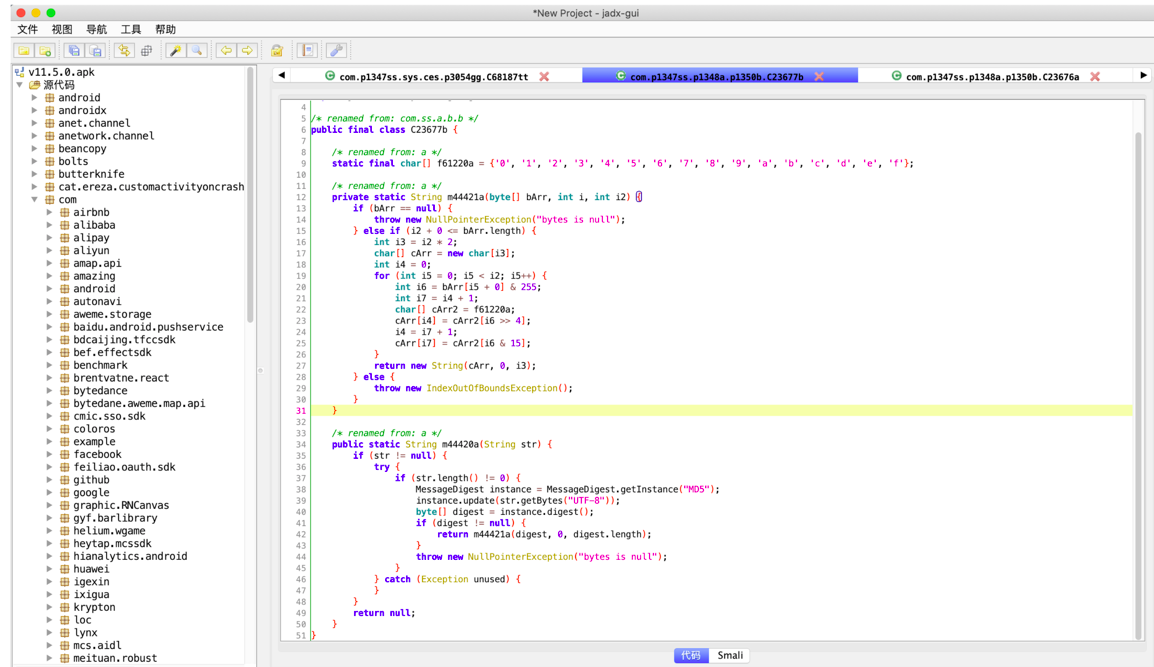
import java.security.MessageDigest;
import java.security.NoSuchAlgorithmException;
import java.util.Arrays;
import java.util.Base64;
public class Hello {
public static void main(String[] args) throws NoSuchAlgorithmException {
String name = "武沛齐";
MessageDigest instance = MessageDigest.getInstance("MD5");
byte[] nameBytes = instance.digest(name.getBytes());
// 十六进制展示
StringBuilder sb = new StringBuilder();
for(int i=0;i<nameBytes.length;i++){
int val = nameBytes[i] & 255; // 负数转换为正数
if (val<16){
sb.append("0");
}
sb.append(Integer.toHexString(val));
}
String hexData = sb.toString();
System.out.println(hexData); // e6ada6e6b29be9bd90
}
}import hashlib
m = hashlib.md5()
m.update("武沛齐".encode("utf-8"))
v1 = m.digest()
print(v1) # b'\x175\x10\x12G$)\xd5-\x0c\r#\xd4h\x17='
v2 = m.hexdigest()
print(v2) # 17351012472429d52d0c0d23d468173d关于加盐:
import java.security.MessageDigest;
import java.security.NoSuchAlgorithmException;
import java.util.Arrays;
import java.util.Base64;
public class Hello {
public static void main(String[] args) throws NoSuchAlgorithmException {
String name = "武沛齐";
MessageDigest instance = MessageDigest.getInstance("MD5");
instance.update("xxxxxx".getBytes());
byte[] nameBytes = instance.digest(name.getBytes());
System.out.println(Arrays.toString(nameBytes));
String res = new String(nameBytes);
System.out.println(res);
// 十六进制展示
StringBuilder sb = new StringBuilder();
for(int i=0;i<nameBytes.length;i++){
int val = nameBytes[i] & 255; // 负数转换为正数
if (val<16){
sb.append("0");
}
sb.append(Integer.toHexString(val));
}
String hexData = sb.toString();
System.out.println(hexData); // e6ada6e6b29be9bd90
}
}
import hashlib
m = hashlib.md5("xxxxxx".encode('utf-8'))
m.update("武沛齐".encode("utf-8"))
v2 = m.hexdigest()
print(v2) # 17351012472429d52d0c0d23d468173dsha-256加密
B站:x/report/andriod2,请求体
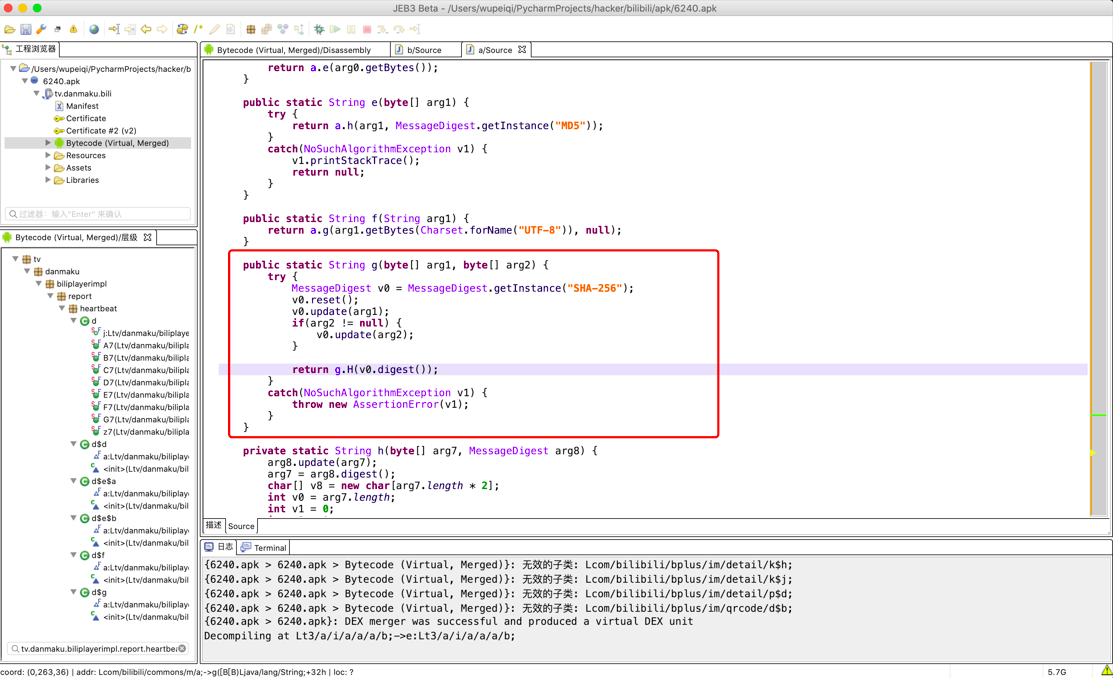
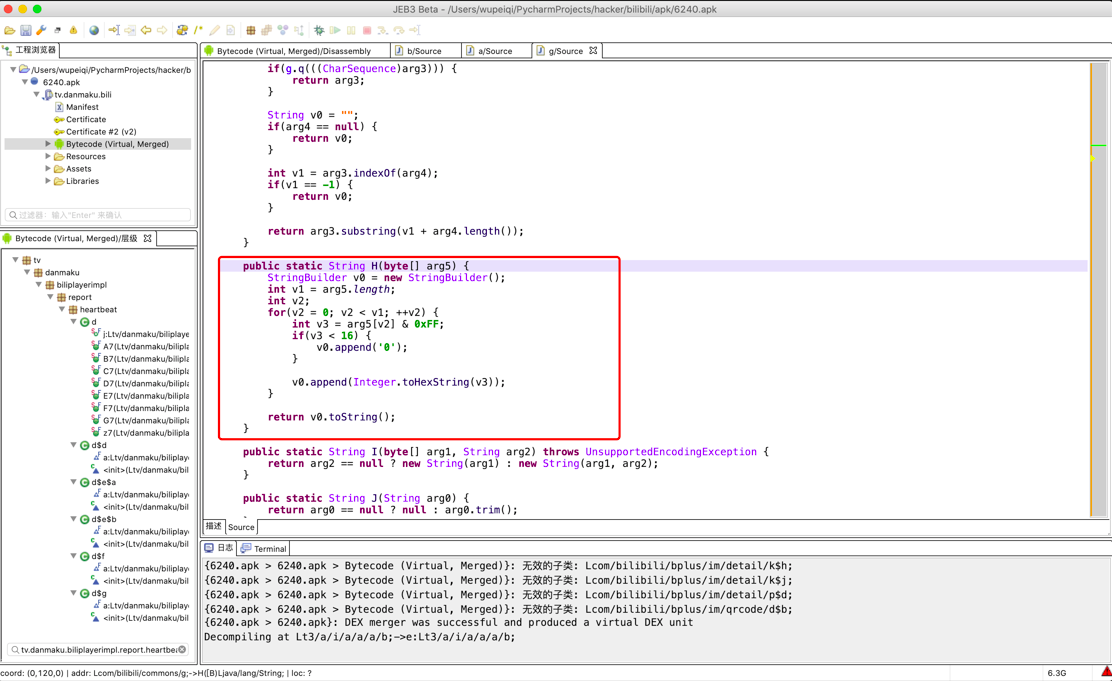
import java.security.MessageDigest;
import java.security.NoSuchAlgorithmException;
import java.util.Arrays;
import java.util.Base64;
public class Hello {
public static void main(String[] args) throws NoSuchAlgorithmException {
String name = "武沛齐";
MessageDigest instance = MessageDigest.getInstance("SHA-256");
byte[] nameBytes = instance.digest(name.getBytes());
// System.out.println(Arrays.toString(nameBytes));
// String res = new String(nameBytes);
// System.out.println(res);
// 十六进制展示
StringBuilder sb = new StringBuilder();
for(int i=0;i<nameBytes.length;i++){
int val = nameBytes[i] & 255; // 负数转换为正数
if (val<16){
sb.append("0");
}
sb.append(Integer.toHexString(val));
}
String hexData = sb.toString();
System.out.println(hexData); // e6ada6e6b29be9bd90
}
}import hashlib
m = hashlib.sha256()
m.update("武沛齐".encode("utf-8"))
v2 = m.hexdigest()
print(v2)AES加密
对称加密
-
key & iv ,明文加密。【app端】
-
key & iv ,解密。【API】
情况A: 请求体密文(抓包乱码)
情况B: sign,AES加密+base64编码刷B站播放时,发送POST请求。
AES加密(请求体中的数据) -> 密文(JS央视频 key & iv & 加密)。

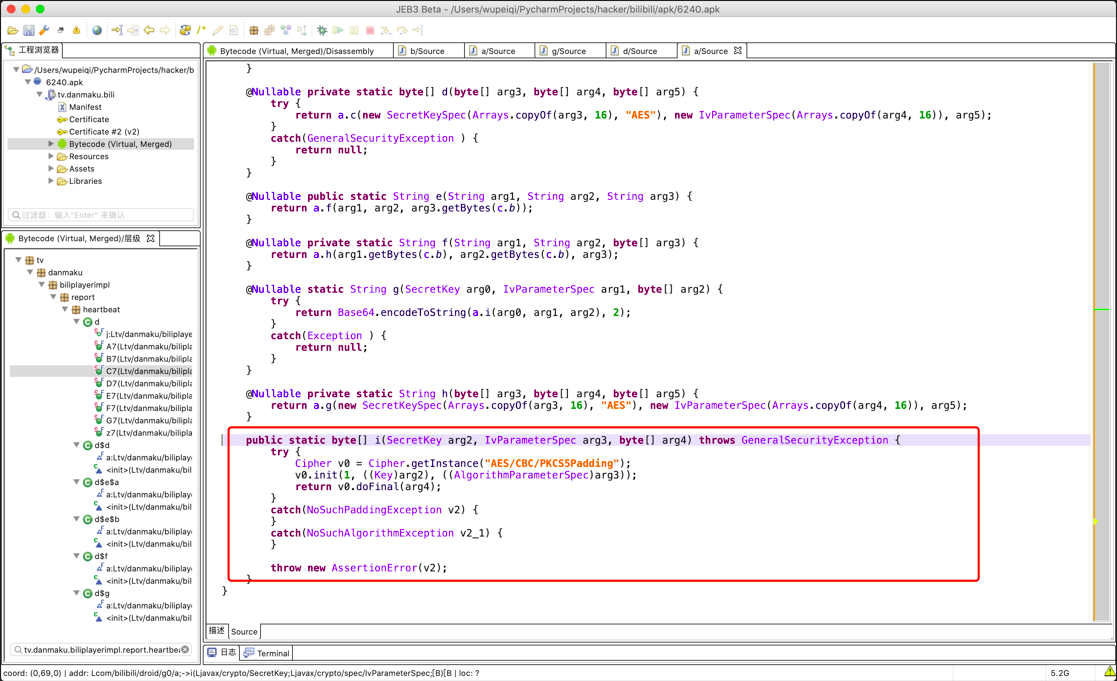
import javax.crypto.BadPaddingException;
import javax.crypto.Cipher;
import javax.crypto.IllegalBlockSizeException;
import javax.crypto.NoSuchPaddingException;
import javax.crypto.spec.IvParameterSpec;
import javax.crypto.spec.SecretKeySpec;
import java.io.UnsupportedEncodingException;
import java.security.InvalidAlgorithmParameterException;
import java.security.InvalidKeyException;
import java.security.MessageDigest;
import java.security.NoSuchAlgorithmException;
import java.util.Arrays;
import java.util.Base64;
public class Hello {
public static void main(String[] args) throws Exception {
String data = "武沛齐";
String key = "fd6b639dbcff0c2a1b03b389ec763c4b";
String iv = "77b07a672d57d64c";
Cipher cipher = Cipher.getInstance("AES/CBC/PKCS5Padding");
// 加密
byte[] raw = key.getBytes();
SecretKeySpec skeySpec = new SecretKeySpec(raw, "AES");
IvParameterSpec ivSpec = new IvParameterSpec(iv.getBytes());
cipher.init(Cipher.ENCRYPT_MODE, skeySpec, ivSpec);
byte[] encrypted = cipher.doFinal(data.getBytes());
// System.out.println(Arrays.toString(encrypted));
}
}# pip install pycryptodome
from Crypto.Cipher import AES
from Crypto.Util.Padding import pad
KEY = "fd6b639dbcff0c2a1b03b389ec763c4b"
IV = "77b07a672d57d64c"
def aes_encrypt(data_string):
aes = AES.new(
key=KEY.encode('utf-8'),
mode=AES.MODE_CBC,
iv=IV.encode('utf-8')
)
raw = pad(data_string.encode('utf-8'), 16)
return aes.encrypt(raw)
data = aes_encrypt("武沛齐")
print(data)
print([ i for i in data])
base64编码
import java.util.Base64;
public class Hello {
public static void main(String[] args) {
String name = "武沛齐";
// 编码
Base64.Encoder encoder = Base64.getEncoder();
String res = encoder.encodeToString(name.getBytes());
System.out.println(res); // "5q2m5rK\n6b2Q"
// 解码
Base64.Decoder decoder = Base64.getDecoder();
byte[] origin = decoder.decode(res);
String data = new String(origin);
System.out.println(data); // 武沛齐
}
}import base64
name = "武沛齐"
res = base64.b64encode(name.encode('utf-8'))
print(res) # b'5q2m5rKb6b2Q'
data = base64.b64decode(res)
origin = data.decode('utf-8')
print(origin) # "武沛齐"
# 不同,换行符 + ==



 浙公网安备 33010602011771号
浙公网安备 33010602011771号